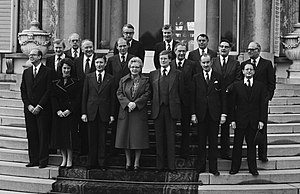First Van Agt cabinet Van Agt–Wiegel cabinet | |
|---|---|
Cabinet of the Netherlands | |
  Installation of the cabinet by Queen Juliana at Soestdijk Palace on 19 December 1977 | |
| Date formed | 19 December 1977 |
| Date dissolved | 11 September 1981 3 years, 266 days in office (Demissionary from 26 May 1981) |
| People and organisations | |
| Monarch | Queen Juliana (1977–1980) Queen Beatrix (1980–1981) |
| Prime Minister | Dries van Agt |
| Deputy Prime Minister | Hans Wiegel |
| No. of ministers | 17 |
| Ministers removed | 5 |
| Total no. of members | 21 |
| Member party | Christian Democratic Appeal (CDA) People's Party for Freedom and Democracy (VVD) |
| Status in legislature | Centre-right Majority government |
| History | |
| Election | 1977 election |
| Outgoing election | 1981 election |
| Legislature terms | 1977–1981 |
| Incoming formation | 1977 formation |
| Outgoing formation | 1981 formation |
| Predecessor | Den Uyl cabinet |
| Successor | Second Van Agt cabinet |
| Part of the Politics series |
![Azure, billetty Or a lion with a coronet Or armed and langued Gules holding in his dexter paw a sword Argent hilted Or and in the sinister paw seven arrows Argent pointed and bound together Or. [The seven arrows stand for the seven provinces of the Union of Utrecht.] The shield is crowned with the (Dutch) royal crown and supported by two lions Or armed and langued gules. They stand on a scroll Azure with the text (Or) "Je Maintiendrai" (French for "I will maintain".)](http://upload.wikimedia.org/wikipedia/commons/thumb/8/8f/State_coat_of_arms_of_the_Netherlands.svg/150px-State_coat_of_arms_of_the_Netherlands.svg.png) |
|---|
|
|
The first Van Agt cabinet, also called the Van Agt–Wiegel cabinet was the executive branch of the Dutch Government from 19 December 1977 until 11 September 1981. The cabinet was formed by the christian-democratic Christian Democratic Appeal (CDA) and the conservative-liberal People's Party for Freedom and Democracy (VVD) after the election of 1977. The cabinet was a centre-right coalition and had a slim majority in the House of Representatives with Christian Democratic Leader Dries van Agt serving as Prime Minister. Liberal Leader Hans Wiegel served as Deputy Prime Minister and Minister of the Interior.
The cabinet served in the final years of the radical 1970s and the early years of the economic expansion of the 1980s. Domestically it had to deal with the last days of the counterculture, the abdication of Queen Juliana and the installation of Queen Beatrix, a growing inflation following the recession in the 1980s but it was able to implement several major social reforms to the public sector and civil reforms and stimulating deregulation and privatization. Internationally it had to deal with the 1979 oil crisis and the fallout of the increasing international stand against Apartheid in South Africa. The cabinet suffered several major internal and external conflicts including multiple cabinet resignations, including a informal caucus of several Christian Democrats in the House of Representatives that only supported the cabinet in a confidence and supply construction, but it was able to complete its entire term and was succeeded by the Second Van Agt cabinet following the election of 1981.[1][2][3]
- ^ "Partij of Principes – De dissidenten binnen het kabinet Van Agt/Wiegel" (in Dutch). Andere Tijden. 23 September 2010. Retrieved 16 February 2018.
- ^ (in Dutch) Dries van Agt (1931), Absolutefacts.nl, 10 December 2008
- ^ (in Dutch) Wiegel houdt belofte van terugkeer levend, Trouw, 24 February 2005